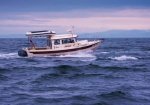The answer is no. The factors most likely to cause a problem is a boat kept outdoors in an environment where the boat is not covered in the winter, gets water in the cockpit, and then subjected to freeze thaw cycles.
The second factor is if there are penetrations in the core where water goes in thru a screw hole--most of those are boats where the fuel tanks have several screws holding down the fuel tank, and there is water left standing. A boat which has been covered, trailer kept or in mild dry climates is far less likely to have any core problems.
Right now there are several boats undergoing restoration from a wet core--the worse one I have ever seen is the 12 year old boat, and there is a bout 28 year old boat both of which were kept in AK, out of doors. I had a 25 with cockpit core issues (the 25 has a cockpit floor over the fuel tank). The hull was fine. But the boat sat out in 2 New Jersy winters, with no cover. Then a heavy person jumped onto the cockpit broke the fiberglass near a hatch, and then sat out another winter. That boat had also been abused badly. $3000 worth of materials, and the boat was as good as new--transom was fine, and boat bottom was fine--the cockpit was rebuilt using Nadicore.--a honeycomb plastic core material, with fiberglass mat scrim.
Balsa has some real advantages of shear load resistance, and compression over some of the foams and other core materials. If properly encapsulated it lasts many years. Look at the number of 20 to 40 year old C Dorys with zero major issues!
A good survey will find the problems. Some surveyors are better than others: tools, phenolic hammer, moisture meter and in some cases FLIR imaging. Ultrasound plays a role, but few surveyors are skilled in this technology.

